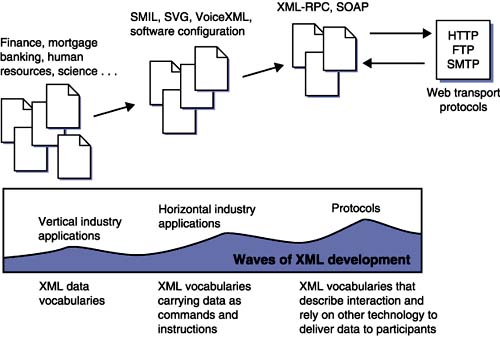| XML is used as a data description language for various vertical industries. | Although XML is a relatively new technology, in just a few short years it has been applied in a variety of areas. Because of XML's origins in the Standard Generalized Markup Language (SGML) world, the first XML applications were versions of existing SGML applications. These were primarily vocabularies for specific industries such as finance, banking, science and technology, and human resources. | XML is used to provide cross-industry functionality. | However, as Figure 3.1 makes clear, XML is not limited to industry- specific data descriptions. XML has been successfully applied to problems that span industry segments. These applications, known as horizontal industry applications, provide functionality and services that are more general in nature and can be applied in different ways to different industries. Typically, these XML vocabularies go beyond simple data description and take on issues of configuration and action. Included in this category are XML vocabularies such as Scalable Vector Graphics (SVG) for describing two-dimensional graphics in XML; Synchronized Multimedia Integration Language (SMIL), which defines elements and attributes that describe the presentation of multimedia presentations; VoiceXML, for describing dialogs between a server and an end- user with access to a telephone or voice-enabled browser; and Enterprise JavaBeans (EJB) description languages that are used to configure EJB software on servers. These applications, characterized by using XML to describe both data and declarative actions, open up new ways of delivering application functionality using a simple tag-based syntax. Figure 3.1. XML in practice across vertical and horizontal industry areas.   |



